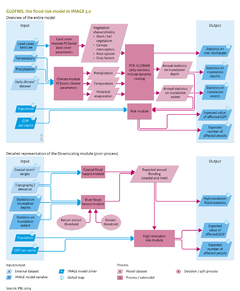Flood risks/Description: Difference between revisions
Jump to navigation
Jump to search
ArnoBouwman (talk | contribs) No edit summary |
ArnoBouwman (talk | contribs) No edit summary |
||
| Line 1: | Line 1: | ||
{{ComponentDescriptionTemplate | {{ComponentDescriptionTemplate | ||
|Status=On hold | |Status=On hold | ||
|Description=The purpose of the [[GLOFRIS model]] ([[Winsemius et al., 2012]]) is to estimate the effect of land cover and climate change on flood risks in river catchments and coastal areas on a global level. The global flood risks are expressed in the projected number of people affected, annually, and in GDP value. GLOFRIS uses land-cover input from [[IMAGE model|IMAGE]] and climate time series, such as the IPCC GCM projections. These input data drive a global hydrological model ([[PCR-GLOBWB model| PCR-GLOBWB]], the computational core of the module). PCR-GLOBWB calculates where and when flooding events may occur, and calculates the inundation extent and depth needed to estimate flood risks. PCR-GLOBWB has features (daily time steps and proper accounting of the relationship between non-linear soil moisture and run-off) that make this model appropriate for simulating flooding events. The spatial resolution currently used by the model is 0.5 x 0.5 degrees (and 5 x 5 minute resolution, currently under development). The different model steps of the main GLOFRIS module are shown in {{FigureTemplate|Flowchart FR}}. | |Description=The purpose of the [[GLOFRIS model]] ([[Winsemius et al., 2012]]) is to estimate the effect of land cover and climate change on flood risks in river catchments and coastal areas on a global level. The global flood risks are expressed in the projected number of people affected, annually, and in GDP value. GLOFRIS uses land-cover input from [[IMAGE land use model|IMAGE]] and climate time series, such as the IPCC GCM projections. These input data drive a global hydrological model ([[PCR-GLOBWB model| PCR-GLOBWB]], the computational core of the module). PCR-GLOBWB calculates where and when flooding events may occur, and calculates the inundation extent and depth needed to estimate flood risks. PCR-GLOBWB has features (daily time steps and proper accounting of the relationship between non-linear soil moisture and run-off) that make this model appropriate for simulating flooding events. The spatial resolution currently used by the model is 0.5 x 0.5 degrees (and 5 x 5 minute resolution, currently under development). The different model steps of the main GLOFRIS module are shown in {{FigureTemplate|Flowchart FR}}. | ||
The land-cover map ‘Global Land Cover Characterization’ (GLCC) ([[Loveland et al., 2000]]) is the basis of the parameters of the PCR-GLOBWB hydrological model ({{FigureTemplate|Flowchart FR}}). These parameters express the hydrological characteristics of different land-cover types. IMAGE and PCR-GLOBWB are linked by lookup tables that translate the IMAGE land-cover classification into that of GLCC. | The land-cover map ‘Global Land Cover Characterization’ (GLCC) ([[Loveland et al., 2000]]) is the basis of the parameters of the PCR-GLOBWB hydrological model ({{FigureTemplate|Flowchart FR}}). These parameters express the hydrological characteristics of different land-cover types. IMAGE and PCR-GLOBWB are linked by lookup tables that translate the IMAGE land-cover classification into that of GLCC. | ||
| Line 17: | Line 17: | ||
After the high-resolution flood hazard maps have been established, the annual extreme values can be combined to form average annual flood hazard maps and flood risk maps. At this scale, also more local detail can be applied about cropland locations, high-resolution maps on population and GDP or other exposure data of interest to the user. The resulting flood hazard maps can be combined with these high-resolution maps on population and GDP and, if possible, more localised damage models. | After the high-resolution flood hazard maps have been established, the annual extreme values can be combined to form average annual flood hazard maps and flood risk maps. At this scale, also more local detail can be applied about cropland locations, high-resolution maps on population and GDP or other exposure data of interest to the user. The resulting flood hazard maps can be combined with these high-resolution maps on population and GDP and, if possible, more localised damage models. | ||
More information about GLOFRIS, its underlying models and methods, as well as the downscaling module can be found in Winsemius et al. ([[Winsemius et al., 2012]]). | More information about GLOFRIS, its underlying models and methods, as well as the downscaling module can be found in Winsemius et al. ([[Winsemius et al., 2012]]). | ||
}} | }} | ||
Revision as of 12:45, 9 December 2013
Parts of Flood risks/Description
| Component is implemented in: |
|
| Related IMAGE components |
| Models/Databases |
| Key publications |
| References |
